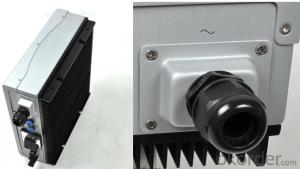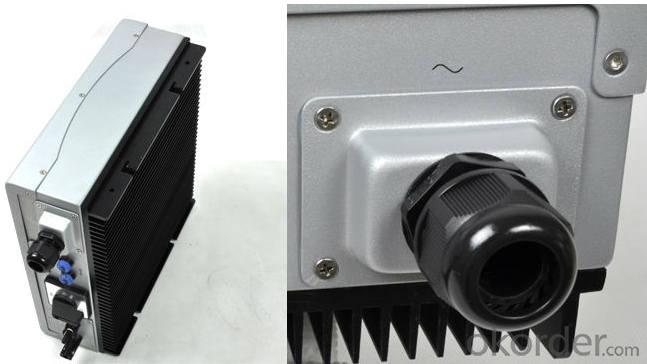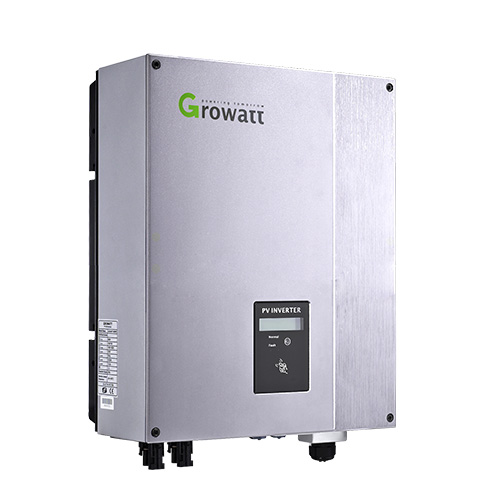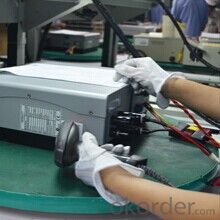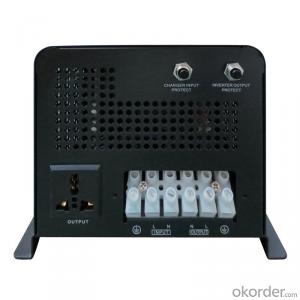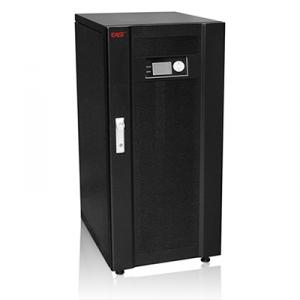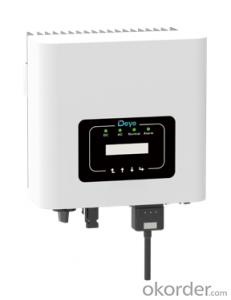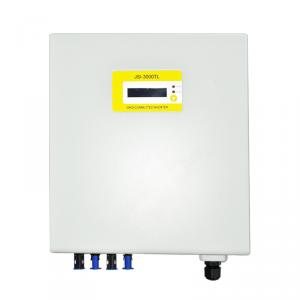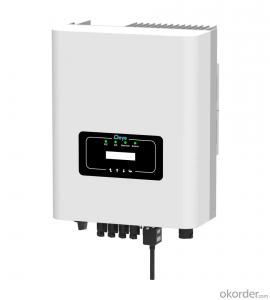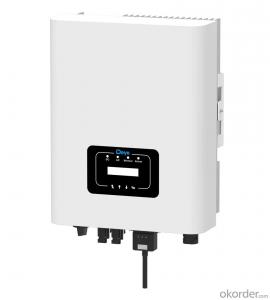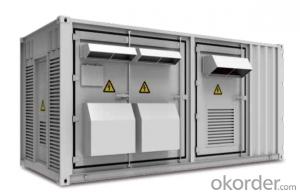Solar Inverter Price 2500MTL-3000MTL 2MPPT, Single Phase
- Loading Port:
- Shekou
- Payment Terms:
- TT or LC
- Min Order Qty:
- 10 pc
- Supply Capability:
- 100000 pc/month
OKorder Service Pledge
OKorder Financial Service
You Might Also Like
Solar inverter 2500MTL-3000MTL 2MPPT, single phase
Specifications
Maximum efficiency of 98% and wide input voltage range
Internal DC switch
Transformerless GT topology
Multi MPPT
Solar inverter General Descriptions
Leading-Edge Technology
> Maximum efficiency of 97.9 % and wide input voltage range
> Muti MPP controller
> Internal DC switch
> Transformerless H6 topology
> Compact design
> Muti MPP control
> MTL-String
> Bluetooth technology
> Easy installation
> Sound control
Europe /Australia ENS
> Simple national setting of line supply monitoring (ENS)
> Easy country configuration
> Muti-language display
> Currently available for Germany,France,UK,Austria,Switzerland,Italy and Spain
Solar inverter Communications
> RS485 /RS232/GPRS interfaces
> Computer monitoring software
Safety
> Full protection functions:DC reverse polarity, AC short-circuit protection, ground fault monitoring, grid monitoring, integrate all-pole sensitive, leakage current monitoring unit.
> Standards complied: SAA, CE/TUV, EN50178, VDE 0126-1-1,IEC 62109,RD 1663,G83,EN 61000-6-1,EN61000-6-2 ,EN61000-6-3,EN61000-6-4, DK5940, G83, RD1663, VDE-AR-N415, CEI 0-21
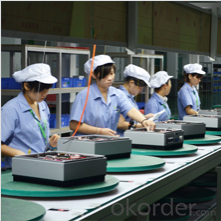
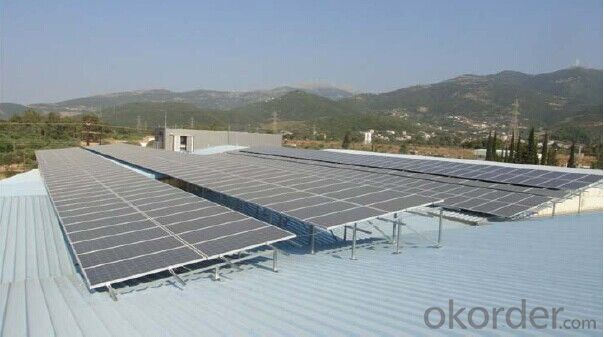
Technical Specifications
Model | 2500MTL | 3000MTL |
INPUT DATA | ||
Max. DC Voltage | 500V | 500V |
PV voltage range | 200V~500V | 200V~500V |
MPP Voltage Range | 200V~450V | 200V~450V |
Max. DC Power | 2700W | 3200W |
Max. Input Current | 10A/10A | 10A/10A |
Number of MPP Trackers/ | 2/1 | 2/1 |
Strings Per MPP Tracker | ||
OUTPUT DATA | ||
Nominal AC Output | 2500W | 3000W |
Max.Output Current | 12.5A | 15A |
Grid Voltage Range | 180~280V | 180~280V |
Rated Grid Frequency | 50Hz/60Hz | 50Hz/60Hz |
Output Current THD | < 3% | < 3% |
AC connection | Single phase | Single phase |
SYSTEM | ||
Max. Efficiency | 97.50% | 97.50% |
Euro. Efficiency | 97.00% | 97.40% |
MPPT efficiency | 99.50% | 99.50% |
Protection Degree | IP65(outdoor) | IP65(outdoor) |
Operating Temperature | -25~+60°C | -25~+60°C |
Cooling Method | No fan | No fan |
Display | LCD | LCD |
Standard Comm. Interfaces | RS485/RS232 | RS485/RS232 |
Optional Comm. Interfaces | GPRS/blue tooth | GPRS/blue tooth |
MECHANICAL DATA | ||
Dimensions(WxHxD) | 360/510/188mm | 360/510/188mm |
Net Weight | 15.6kg | 15.6kg |
Solar inverter FAQ
1. Have any design tool and how to use it?
Shine Design is the system design software just for inverters, It can conduct installers to figure out panel numbers for a system, panel numbers for each string, and which inverter model is suitable for the system. Moreover, it can print a design report after input all necessary parameters, can calculate DC/AC wire wastage, annual generation, etc.
2. Does the inverter have monitoring solutions for residential system?
For small rating system, we have wired two monitoring solution (ShineNet via RS232 or RS485). (a) Local wireless monitoring solution (ShineVision via RF module communication) (b) Global wireless monitoring solution (WIFI module via WIFI network)
3. Do you have free solution for monitoring?
ShineNet is an inverter monitoring software run in Windows XP, Windows Vista, Windows 7 operating system. It can monitor inverter via RS232 (or RS232 convert to USB cable) and RS485 wire connection. Customers can purchase the cable locally to get the inverter monitored, it is simple.
- Q: Can I connect solar panels directly to the grid without an inverter?
- No, you cannot connect solar panels directly to the grid without an inverter. An inverter is necessary to convert the direct current (DC) generated by the solar panels into alternating current (AC) that can be used by the electrical grid.
- Q: What certifications should a solar inverter have?
- A solar inverter should have certifications such as UL 1741, IEC 62109, and IEEE 1547 to ensure its compliance with safety standards, grid interconnection requirements, and performance reliability.
- Q: How does a solar inverter handle voltage harmonics?
- A solar inverter handles voltage harmonics by using filtering techniques and advanced control algorithms. These methods help to smooth out the output voltage waveform, reducing or eliminating any unwanted harmonics.
- Q: What is the role of power factor correction in a solar inverter?
- The role of power factor correction in a solar inverter is to improve the efficiency and stability of the system by minimizing the reactive power and optimizing the power factor. This ensures that the inverter operates at its highest efficiency and reduces any voltage drops or disturbances in the grid. Additionally, power factor correction helps to comply with grid regulations and standards, preventing penalties and ensuring smooth integration of solar power into the electrical grid.
- Q: How do you connect a solar inverter to solar panels?
- To connect a solar inverter to solar panels, you need to follow a few steps. First, ensure that the solar panels are properly installed and positioned to receive maximum sunlight. Then, connect the positive and negative terminals of the solar panels to the corresponding terminals on the solar inverter. Make sure to use appropriate cables and connectors for a secure connection. Once the connections are made, the solar inverter will convert the solar energy generated by the panels into usable electricity for your home or business.
- Q: What is the difference between a central inverter and a string inverter?
- A central inverter is a type of inverter that is used in large-scale solar installations. It takes the direct current (DC) electricity generated by multiple solar panels and converts it into alternating current (AC) electricity that can be used to power homes or businesses. A central inverter is typically located in a central location, such as a utility room or basement. On the other hand, a string inverter is a type of inverter that is used in smaller-scale solar installations. It also converts DC electricity from multiple solar panels into AC electricity, but it does so at the string level. This means that each string of solar panels has its own dedicated inverter. String inverters are usually installed near the solar panels themselves, which can make them more convenient for maintenance and troubleshooting. In summary, the main difference between a central inverter and a string inverter is the scale of the solar installation they are used in and their physical location. Central inverters are used in larger installations and are located centrally, while string inverters are used in smaller installations and are located near the solar panels.
- Q: Can a solar inverter be used with a solar-powered emergency lighting system?
- Yes, a solar inverter can be used with a solar-powered emergency lighting system. The solar inverter is responsible for converting the DC (direct current) power generated by the solar panels into AC (alternating current) power that can be used to power the emergency lighting system. This allows the system to store excess energy in batteries and provide uninterrupted power during emergency situations.
- Q: What is the role of a solar inverter in a solar-powered remote monitoring system?
- The role of a solar inverter in a solar-powered remote monitoring system is to convert the direct current (DC) electricity generated by the solar panels into alternating current (AC) electricity that can be used to power the monitoring system. It also ensures that the electricity generated matches the requirements of the monitoring equipment, regulates the voltage, and assists in efficient power transmission and distribution.
- Q: How does a hybrid solar inverter work?
- A hybrid solar inverter works by converting the direct current (DC) electricity generated by solar panels into alternating current (AC) electricity that can be used to power household appliances or fed back into the grid. It also has the capability to store excess solar energy in batteries for later use, ensuring continuous power supply even during periods of low sunlight or power outages. This enables users to maximize their solar energy utilization and reduce dependence on the grid.
- Q: Can a solar inverter be used with a solar-powered water heating system?
- Yes, a solar inverter can be used with a solar-powered water heating system. The solar inverter converts the direct current (DC) generated by the solar panels into alternating current (AC) that can be used to power the water heating system. This allows for efficient utilization of solar energy and ensures the water heating system operates effectively.
Send your message to us
Solar Inverter Price 2500MTL-3000MTL 2MPPT, Single Phase
- Loading Port:
- Shekou
- Payment Terms:
- TT or LC
- Min Order Qty:
- 10 pc
- Supply Capability:
- 100000 pc/month
OKorder Service Pledge
OKorder Financial Service
Similar products
Hot products
Hot Searches
Related keywords
